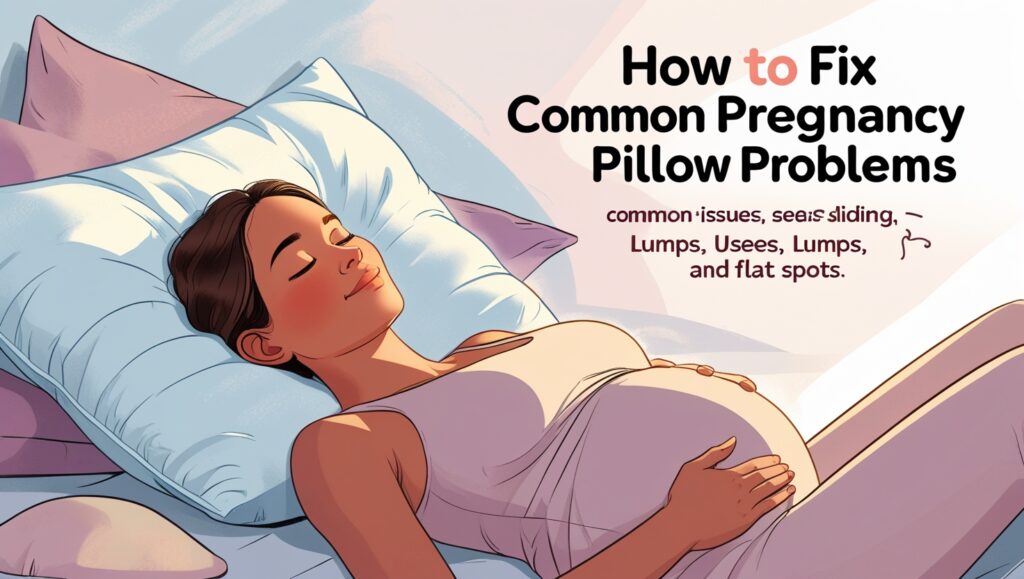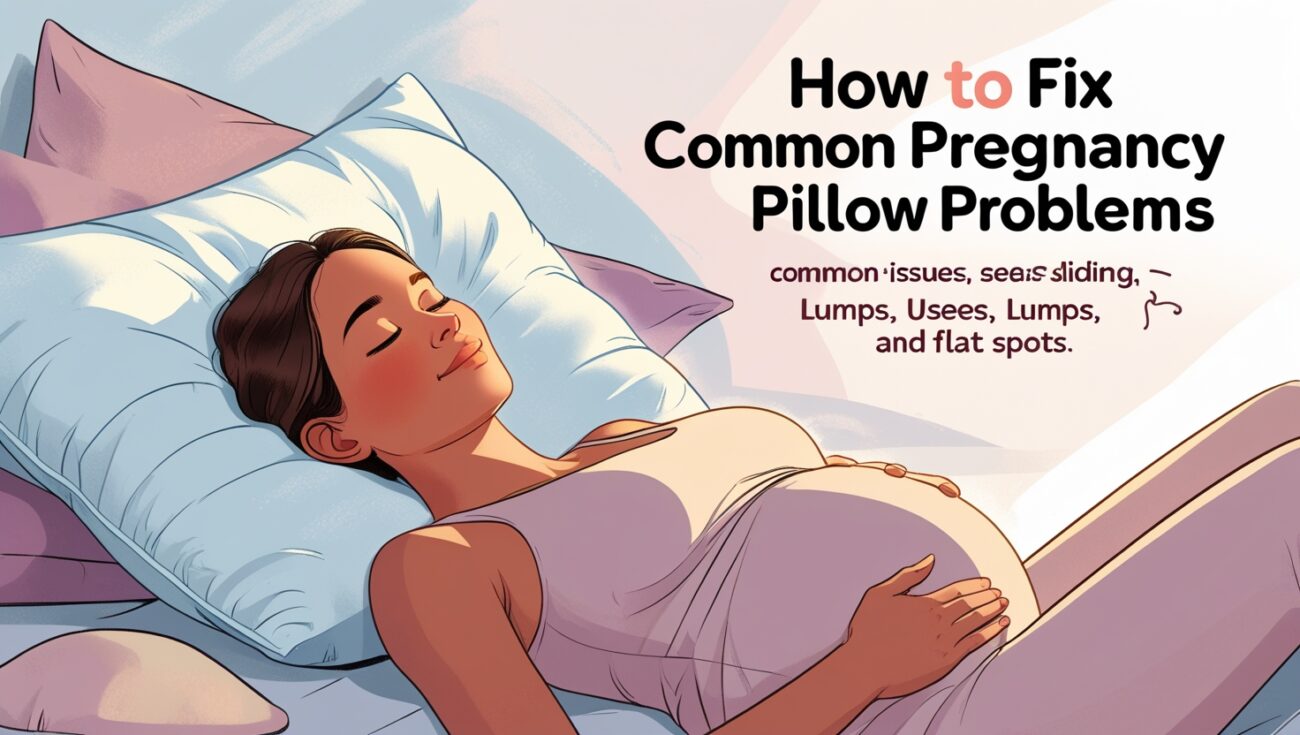How to Fix Common Pregnancy Pillow Problems (Sliding, Lumps, Flat Spots)
Simple solutions to make your pillow last longer and feel brand new again
When I bought my first pregnancy pillow, I thought it would be the perfect, no-maintenance comfort tool. But after a few weeks, I noticed problems—it kept sliding out of place, lumps were forming, and some parts felt completely flat.
Instead of buying a new one, I figured out easy ways to fix these issues so my pillow could keep supporting me all the way through pregnancy (and even postpartum). If you’re having the same struggles, here’s how to bring your pregnancy pillow back to life.

Table of Contents
Problem #1: The Pillow Keeps Sliding Around
If your pregnancy pillow moves out of position during the night, it can ruin your sleep. I fixed this in a few ways:
- Use a textured or non-slip pillow cover – Cotton or jersey-knit covers grip the bed better than smooth microfiber.
- Place a non-slip rug pad or shelf liner under the pillow to keep it in place.
- Tuck part of the pillow under your body so your weight naturally holds it still.
➡️ Shop my favorite non-slip pregnancy pillow covers on Amazon
Problem #2: Lumps in the Filling
Lumps form when the filling shifts or clumps together, especially after washing. Here’s how I fixed mine:
- Shake and fluff the pillow daily to keep the filling even.
- For stubborn lumps, massage the area with your hands to break up the clumps.
- If the pillow has a zipper, open it and redistribute the stuffing by hand. You can even add extra fill if needed.
➡️ This hypoallergenic pillow filling works great for refilling lumps (Amazon)
Problem #3: Flat Spots
Flat spots happen when the same area gets the most pressure night after night. My solution:
- Rotate the pillow every few nights so wear is more even.
- Add loose filling to the flattened section if the pillow allows it.
- If the pillow is machine-washable, wash and air dry—water can help fluff the fill back up.
Extra Tips to Keep Your Pregnancy Pillow in Top Shape
- Always use a removable cover to protect from sweat and oils.
- Avoid over-washing the pillow itself—spot clean when possible.
- Store it properly when not in use (don’t fold or cram it in a small space).
- Keep pets off it—pet hair and claws can wear it down faster.
➡️ Browse top-rated pregnancy pillow care accessories here
Final Thoughts
Pregnancy pillows aren’t cheap, so keeping yours in great shape is worth the effort. With just a few adjustments—like adding non-slip grip, refilling flat spots, and fluffing daily—you can extend its life and comfort for months (or even years).
Personally, once I started rotating and fluffing mine daily, I stopped dealing with lumps and my pillow stayed supportive until the very end of my pregnancy.
➡️ Click here to shop my favorite pregnancy pillow maintenance tools on Amazon
One of the first upgrades I made was switching to a thicker, high-friction mattress protector under my sheets. Not only did it protect my mattress, but it created just enough grip so my pillow stopped sliding completely.
I also experimented with tucking the bottom arm of my U-shaped pillow under my fitted sheet. This hack locked it in place while still letting me move freely on top of it.
If you’re constantly adjusting your pillow during the night, try positioning it diagonally instead of straight. This gives you more surface contact with your body, which naturally holds it in place better.
When it came to lumps, I learned the hard way that storing my pillow folded made the problem worse. Folding compresses the filling unevenly and makes clumps more likely. Now I always store mine flat or hanging.
For stubborn lumps, I sometimes use the low-heat setting on my dryer with dryer balls (or clean tennis balls) for 15 minutes. This fluffs the filling and breaks up clumps without damaging the pillow.
If your pillow’s filling is permanently compacted, you can buy bulk polyester or memory foam stuffing to revive it. I’ve done this twice, and it made my pillow feel brand new for under $15.
Flat spots can also be fixed by redistributing filling from lesser-used sections. If your pillow has a zipper, simply move some stuffing from one side to the flattened area and massage it evenly.
Another trick for flat spots is to lay the pillow outside in the sun for a few hours. The heat can help the filling expand, and the fresh air keeps it smelling clean. Just avoid prolonged UV exposure to prevent fabric fading.
If your pregnancy pillow cover is worn out or stretched, replacing it can actually help with shape retention. A snug, high-quality cover gently compresses the filling and keeps it evenly distributed.
To avoid creating new flat spots, I started switching the arm I hug every other night. This spreads pressure more evenly and keeps both sides from wearing down too quickly.
One overlooked problem is moisture build-up. Even small amounts of sweat can weigh down and clump the filling over time. Using a moisture-wicking pillow protector under the cover solved this for me.
Finally, for maximum lifespan, avoid letting kids or pets jump on your pregnancy pillow. The extra weight and pressure can permanently deform the filling, and once that happens, no amount of fluffing can fully restore it.
If your pillow constantly loses its shape overnight, try layering a thin, firm throw blanket under it. This creates extra friction, prevents sliding, and gives the pillow a more stable base—especially on smoother mattresses.
For pillows with removable inner filling bags, shake and flip the bags inside every few days. This redistributes weight and stops certain sections from getting too compressed compared to others.
Lastly, if your pillow feels uneven after washing, air dry it completely before use. Even a little leftover moisture can cause clumps and flat spots. I place mine near an open window with good airflow to speed up the process without overheating the fabric.

